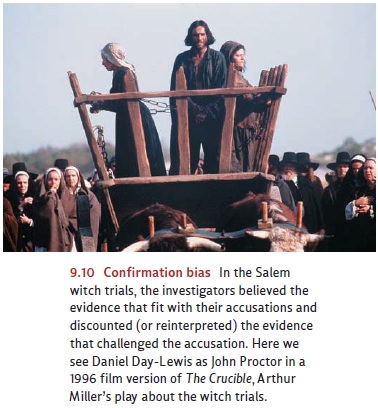Chapter: Psychology: Thinking
Reasoning: Confirmation Bias
Confirmation Bias
One line of research on reasoning
concerns a pattern known as confirmation
bias. This term applies to
several different phenomena but, in general, describes a tendency to take
evidence that’s consistent with our beliefs more seriously than evidence
inconsistent with our beliefs. Thus, when they’re trying to test a belief,
people often tend to seek out information that would confirm the belief rather than information that might challenge the
belief. Likewise, if we give people evidence that’s consistent with their beliefs,
they tend to take this evidence at face value and count it as persuasive— and
so they strengthen their commitment to their beliefs. But if we give people
evidence that’s contrary to their beliefs, they often greet it with skepticism,
look for flaws, or ignore it altogether (Figure 9.10).

This pattern is evident in many
procedures. In one classic study, participants were presented with a balanced package of evidence concerned
with whether capital punishment acts as a deterrent to crime. Half of the evidence
favored the partici-pant’s view, and half challenged that view (C. Lord, Ross,
& Lepper, 1979). We might hope that this balanced presentation would remind
people that there’s evidence on both sides of this issue, and thus reason to
take the opposing viewpoint seriously. This reminder in turn should pull people
away from extreme positions and toward a more moderate stance. Thanks to
confirmation bias, however, the actual outcome was different. The partici-pants
found the evidence consistent with their view to be persuasive and the opposing
evidence to be flimsy. Of course, this disparity in the evidence was created by
the participants’ (biased) interpretation of the facts, and partici-pants with
a different starting position perceived the opposite disparity! Even so,
participants were impressed by what they perceived as the uneven quality of the
evidence, and this led them to shift to views even more extreme than those
they’d had at the start.
Notice the circularity here.
Because of their initial bias, participants perceived an asymmetry in the
evidence—the evidence offered on one side seemed persuasive; the evidence on
the other side seemed weak. The participants then used that asymmetry, created by their bias, to reinforce and
strengthen that same bias.
Confirmation bias can also be
documented outside the laboratory. Many compul-sive gamblers, for example,
believe they have a “winning strategy” that will bring them great wealth. Their
empty wallets provide powerful evidence against this belief, but they stick
with it anyway. How is this possible? In this case, confirmation bias takes the
form of influencing how the gamblers think about their past wagers. Of course,
they focus on their wins, using those instances to bolster the belief that they
have a surefire strategy. What about their past losses? They also consider
these, but usually not as losses. Instead, they regard their failed bets as
“near wins” (“The team I bet on would have won if not for the ref ’s bad
call!”) or as chance events (“It was just bad luck that I got a deuce of clubs
instead of an ace.”). In this way, confirming evidence is taken at face value,
but disconfirming evidence is reinterpreted, leaving the gamblers’ erroneous
beliefs intact (Gilovich, 1991; for other examples of confirmation bias, see
Schulz-Hardt, Frey, Lüthgens, & Moscovici, 2000; Tweney, Doherty, &
Mynatt, 1981; Wason, 1960, 1968).
Related Topics